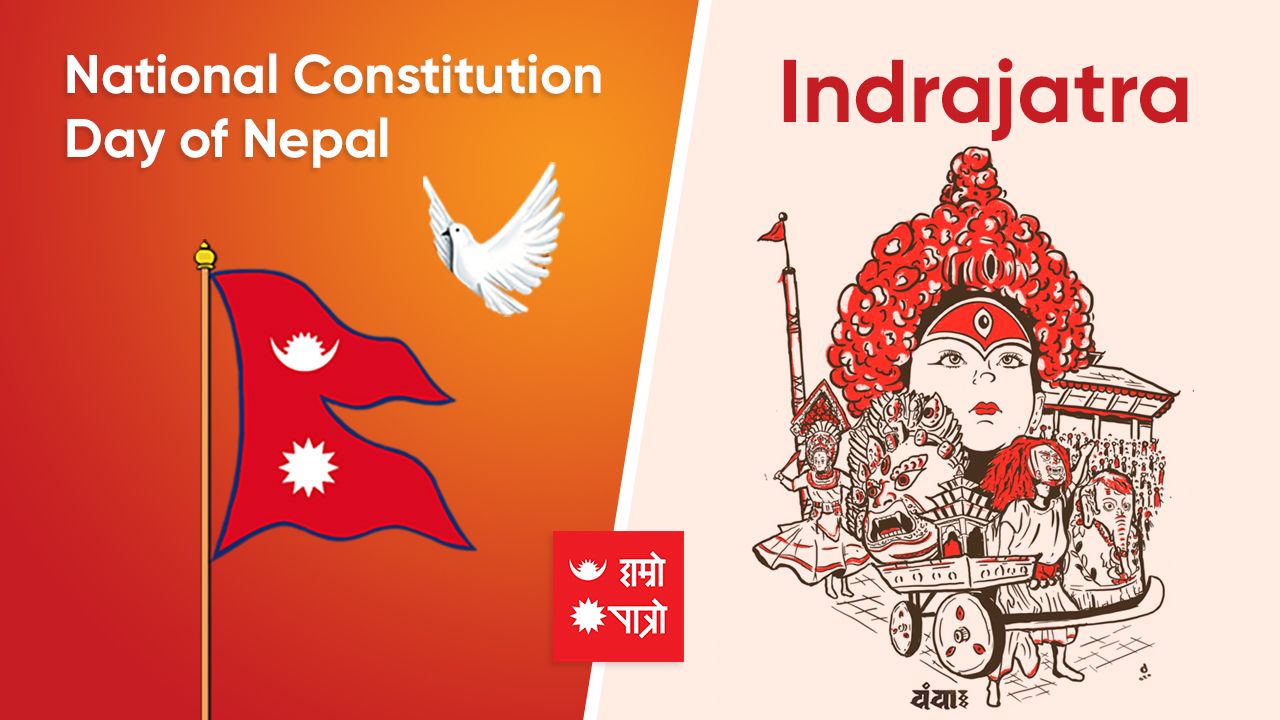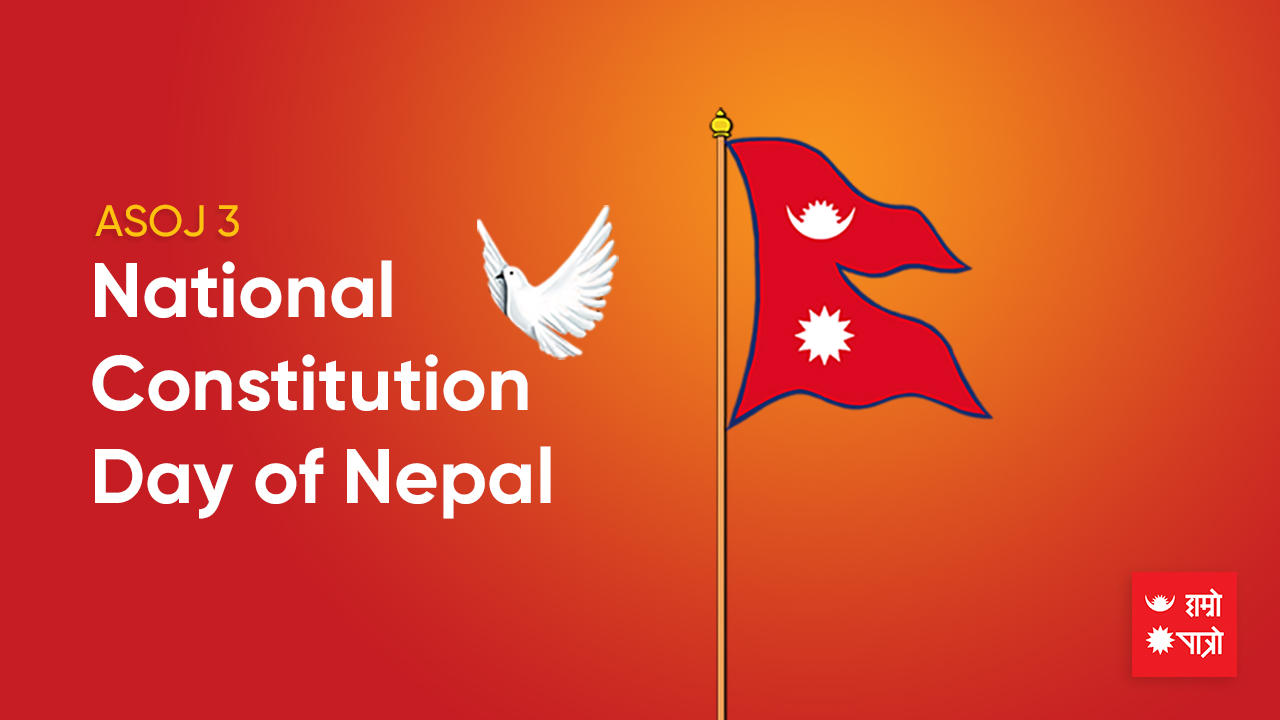
For the first time in the history of the country, the 65-years of aspiration of the people to make a constitution through the elected representatives of the people has come true. This was on the 2072BS Asoj 3, Nepal's first President Ram Baran Yadav signed and approved the "Constitution of Nepal 2072". Today is the Asoj 3rd, the national constitution day of Nepal, the day to commemorate the promulgation of the Nepali constitution. The Constitution of Nepal 2072 brought by the contribution, sacrifice, penance, and sweat of thousands of Nepali has proved to be truly fruitful and auspicious. By the Constitution of the Federal Republic of Nepal 2072 BS, Nepal has moved forward on the path of law and republican rule. According to the draft constitution signed by eight parties including the Maoists, the full constitution has been issued replacing the interim constitution issued on Magh 1st, 2063 BS.
This year's Constitution Day stands in a slightly different environment. The Federal Republic of Nepal has seen many ups and downs since the third year of the majority government in the parliament with an after the elections at every three levels. In the fourth year of this majority government, due to political tensions, there has been a sudden change of government and the government of another coalition has come to power.
The steps and tendencies of the government redefine the constitutional order and democracy for Nepali. Federal Republic of Nepal has come here with many obstacles, issues, and cases along with the achievement of various milestones and benchmarks. May this Constitution Day enhance the voices to lobby justice for Nirmala Pant and many others, expose corruption and bring a new dimension of transparency, expose the many mistakes and corruption cases in the battle with COVID, many things Nepali expect.
After the first Constituent Assembly failed to give a successful draft of the constitution within the stipulated time, the election of the second Constituent Assembly and its consequent effect played a big role in the proclamation of the Constitution of Nepal 2072 BS. Restructuring the state into a federal republic of Nepal, the constitution has transformed the total of seven provinces and the previous constitutional monarchy into a republic and the unitary state structure into federalism. This constitution, which has made it easy for them to get citizenship with the desired gender identity, has given continuity to the abolition of the death penalty like the constitution of 2047 BS. Providing equal rights to daughters in patrimonial property like sons, this constitution is firmly in favor of gender empowerment in all respects and defines Nepal as a secular nation.
Nepal's sovereignty and independence is an example and a matter of pride for the world. Nepali soil and Nepalis have no history of being colonized or under foreign rule by any country till now. After the unification of the nation-builder Prithvi Narayan Shah, the entire territory of the baisey and chaubisey rajyas is a sovereign and independent country. According to the provisions and essence of the constitution, no Nepali today has to tolerate discrimination on the basis of gender, religion, caste, class, color, identity, language, or any other basis. Now the power has been delegated to the provincial and local governments for further development and prosperity.
Federal Republic of Nepal's Constitution 2072 ending all forms of discrimination and oppression created by feudal, autocratic, centralized, and unitary state system; Preserving and promoting unity, socio-cultural solidarity, tolerance, and harmony among diversity by assimilating multi-ethnic, multi-lingual, multi-religious, multi-cultural and geographically diverse characteristics; Resolving to build an egalitarian society based on the principles of proportional, inclusive and participatory to ensure economic equality, prosperity and social justice by ending class, ethnic, regional, linguistic, religious, gender discrimination and all forms of ethnic untouchability.
Despite a number of unusual circumstances, the constitution was announced by a majority of 90 percent of the CA members, setting a rare record in world history.
To date, most of the advanced nations on the world map have not reached a consensus on constitutional arguments at once. Disagreement with the constitution is normal and disagreement is a better chance to be refined. May this constitution also address the issues of the dissenting citizens and commence a new wave of development and brotherhood may spread among all Nepali.
May this constitution bring more pride of being Nepali to the Nepali people. Let there be a mechanism to bring a wave of opportunity and prosperity to this land. We can accommodate everyone under the red and blue umbrella of overall Nepali identity more than the identity of any political party or community. Let there be rule of law, let there be law and justice.
Let everyone have the same voice
I love Nepal
Indra Jatra: Relevance, history, and traditions.

Kathmandu is a city of history precisely a prehistoric city, the origin of the holy Pashupatinath region of Devadeva Mahadev is not mentioned in any scriptures or history copperplate or inscription, but the tolerance, culture, civilization and cultural heritage of this city has become an invaluable ancient asset to the world today. Centuries ago, the most developed nations of today did not even exist on the world map of the world, Kathmandu, had laid the foundations of social development with monasteries, temples of different civilizations, heritages and social structure of justice for equality was institutionalized in Kathmandu.
There is a taste of civilization and peace in the soil and climate of Kathmandu and Kathmandu is not only a city of gods and temples but also a city of many festivals and ancient civilizations with diversity. Indra Jatra i.e. 'Yenya Poonhi' in Nepal language is one of the biggest festivals celebrated in Basantapur, an ancient settlement of Kathmandu city. Let's start with the legend that Lord Indra of the heavens came to Kathmandu in human form to steal the flowers and Parijat required for the fast of Vasundhara Devi, his mother. As lord Indra stole flowers without asking permission from the gardener, they used their tantric power to find Indra and tied him up in the middle of the road.
The idols of Indra tied at Indrachowk, Kilagal and Naradevi in Kathmandu are also displayed in high Dabali, stage. To free her son Indra, who was imprisoned by the people of Kathmandu, his mother herself came to Kathmandu and took Indra back, promising to give adequate fog and mists in return for her son. The legend that rice grows and ripens on time due to the same special fog in this season is still alive in the vernacular. The main function of Indrajatra is to set up a lingo (flag) and organize a rath yatra in a joyous atmosphere.
After the black book/ Goat, prepared for a special ritual by worshiping the tantric method, is left in the forest at Ugrachandi Nala in Kavre district, the first plant's leaf eaten by the goat is cut and the rainbow flag lingo on Ekadashi day is prepared from that tree.
The lingo prepared in this way is also called 'Yonsi' in the local Nepal language. The lingo is placed in front of the idol of the great Kal Bhairav at Hanuman Dhoka in Basantapur Darwar Square. Once this Lingo holds high, Indra Jatra movement commences. However, this year is stagnant, we hope and wish the commemoration could be continued next year. The special lingo prepared in this way is decorated with various symbols and flags. Worship is done by placing a statue of an elephant with Indra at the base of the lingo.
In Kathmandu, the Indra Jatra is believed to have been practiced by the Lichchavikalin king Gunakamdev in the tenth century, while the Kumari Jatra is believed to have started in the mid-eighteenth century. On this day, the unprecedented tolerant relationship between the Buddhist Newa community of Kathmandu and the Newa communities of Hindu faith can be seen in Basantapur Durbar Square in Kathmandu. Thus, the Newa community celebrates Indrajatra with joy and enthusiasm for eight days with various stages and cultural pageants.
Also, three days after the holding of the lingo, Kumari, Ganesh, and Akash Bhairav (Savbhaku), who are living goddesses in the Basantapur Durbar Square area, have a tradition of making a rath yatra. It is also customary to stay awake all night at Indradaha in Dahchok, about 7.2 km west of Kathmandu, and take a bath the next day.
On the third day of the lingo procession, i.e. on the day of Yanlathwa Chaturdashi, the living goddess Kumari, Bhairav and Ganesh, who has been considered by the Newar community as 'Kwahane Ya:', are placed in a chariot and circled in the lower half of the old Kantipur city of Kathmandu. In the evening of the same day, after the chariots of Ganesh, Bhairav and Kumari have been circled, the families of those who have died during the year from Marutol go around Kantipur scattering Satvij.
No, let me correct my statement here, entire Kathmandu and Nepal celebrates the Indra Jatra for eight days. The head of the state and important personalities are present in this celebration, Indra Jatra is as immaculate and accurate as it was since centuries. These centuries-old journeys have continued. The monasteries and temples are not in the same condition after the earthquake to celebrate these processions that have been taking place in front of Basantapur Durbar Square and the heritages but the enthusiasm and hope get multiplied every year.
All need to unite for the traditional continuity of these cultural heritages and its protection. May the blessings of Indra remain, may the crops flourish in the country, and may peace dwell in the hearts of all, best wishes to the Nepalis of Indrajatra.
Ananta Chaturdashi
According to religious beliefs, when the Pandavas lost all their wealth and honor in gambling, they were living a miserable life in the forest with Mrs. Draupadi. At that time, Lord Krishna had requested Yudhisthira to fast reverently on this day. Following the advice of Lord Krishna, the five Pandavas methodically fasted on Ananta Chaturdashi, and the effect of this fast was that the Pandavas were liberated from their miserable lives.
Today is the day of worshiping and adoring Lord Anantnath (Lord Vishnu) and fasting with reverence. Chaturdashi of Bhadra Shukla side is called Ananta Chaturdashi.
ॐ अनन्ताय नम:
Worship method (Puja Method of Anant Chaturdashi)
Today in the morning by bathing etc. daily worship should be prepared with a pure mind. First of all, the urn should be installed and the Ashta Dal should be placed in it and the eternal God of Kush should be established. One should worship Lord Anantnath (Lord Vishnu) with a pure heart by placing an infinite sutra with fourteen knots in front of the urn. It is especially good to worship Ananta Chaturdashi during the day.
Best wishes
Suyog Dhakal
Liked by: